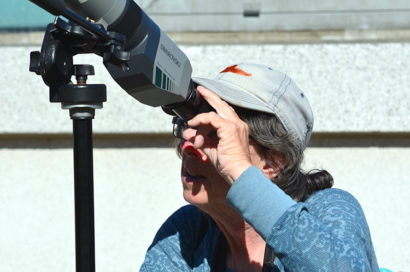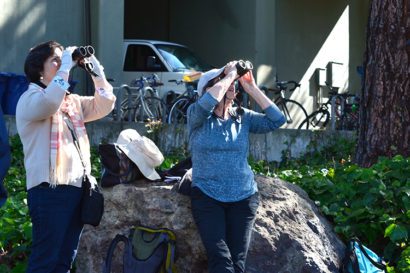Peregrine fledgling takes its first plunge off Campanile
Fiat, so named by the campus community, jumped from the tower’s second balcony on July 3, with its mom and dad following close behind
July 5, 2017
Peregrine falcon chick Fiat, named by the campus community last week, made its first big leap off UC Berkeley’s Campanile on Monday, July 3. CBS San Francisco happened to be at the base of the 307-foot bell tower interviewing fledgling monitors at the time, and caught the action in this broadcast.

Peregrine fledgling Fiat rests in a tree near Stephens Hall after it took flight off the Campanile for the first time. (Photo by Mary Malec)
Mary Malec, a volunteer raptor nest monitor for the East Bay Regional Park District, has been coordinating volunteers on watch for the chicks’ first flights. For the past three days, she’s been stationed near the Campanile, monitoring the peregrines through her scope and taking notes on their movements. Peregrine fledglings fly well, she says, but land badly; the volunteer experts can help them if they find themselves on the ground, where they are most vulnerable.
Fiat, who wears the band 03, jumped from the tower’s second balcony in the early evening Monday and flew into the wind toward Stephens Hall, screaming the whole way, with its mom and dad following close behind. Malec says raptor chicks often scream — much like human babies — when they want attention.
“They scream when they fly. They scream when they’re hungry. They scream when they run around and flap their wings,” she says.
The fledgling landed in a tree, where it was soon harassed by a crow, which Malec thinks might have been calling over other crows to join in the fun. “Crows and ravens harass raptors,” she says. “We don’t know why.” Although the crows would eat a tiny peregrine chick, she adds, they couldn’t make a meal of the full-grown fledgling.

One of the peregrine fledglings looks over the ledge of the Campanile’s second balcony.
The two peregrine chicks — both females — are now as big as their mom at more than a foot tall with a wingspan of more than one yard. Female peregrines, unlike many other bird species, are bigger than males.
By 8:30 p.m. Monday, Fiat had made her way back to the tower. It’s common for fledglings to rest for a day or two after they fly for the first time. Volunteers are keeping a lookout for Lux — the other peregrine chick, also a female — waiting for her to make her daring first leap off the bell tower.
Volunteers will continue to closely monitor the fledglings’ progress for the next few days until both have fledged and can fly with ease. Peregrines can typically fly well after their second or third attempt.
Malec thinks it’s highly likely the peregrine falcon couple will stick around and hatch chicks on the Campanile next year. The only thing that would deter this effort is if one of them died or another, more aggressive female were able to muscle her way in.
In the past few days, four other outside peregrines — two males and two females — have flown into the area, but were chased off by the peregrine couple that has claimed the Campanile as their home. Malec thinks the outsiders were house hunting.
“This is a great territory,” says Malec. “They’ll have to defend it.”
Learn more about the Campanile’s first peregrine family on Berkeley News.

